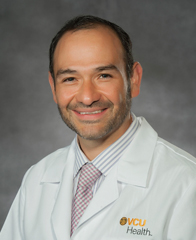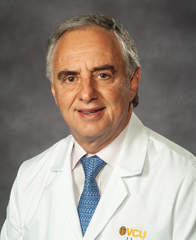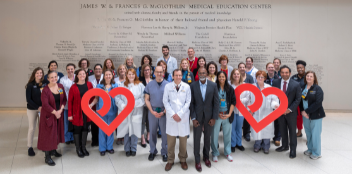Guzman, Exaire Provide Expertise for CTOs
 Dr. Jose Exaire
Dr. Jose Exaire
 Dr. Luis Guzman
Dr. Luis Guzman
The term chronic total occlusion (CTO) refers to the complete blockage of the coronary arteries, the vessels that provide blood to the heart. Over time, the buildup of plaque in these arteries can lead to this condition, which often catches patients by surprise.
“I just had a patient in my office who had a CTO, and she said, `Oh no, I’m doing wonderfully.’ And then when we started to really dig in, she said, `Well, every time that I try to go up the stairs I have to stop in the middle because I’m fatigued,’ or `Every time I go on an incline, I feel something. I thought it was indigestion,’” said Dr. Luis Guzman, director of the cardiac catheterization lab. “She’d had these symptoms for the last two years, and she just adjusted to her life like that.”
Patients accept a lower functionality, he says, overlooking common CTO symptoms such as chest pain, tiredness or shortness of breath. Left untreated, CTOs can cause decreased blood flow to the heart, leading to lower functionality. The condition is diagnosed by way of an angiogram.
CTOs are present in approximately 20-30% of patients with chronic coronary artery disease as well as in those who have had prior bypass surgery, said Guzman. “However, in most of these patients, the CTO is left without any treatment, which is associated with an increased risk of dying from cardiac reasons.”
Minimally invasive options exist in the cath lab setting. Guzman and VCU Health colleague Dr. Jose Exaire are among the very few interventional cardiologists in the country with special training and expertise in treating CTOs using a full combination of techniques, including antegrade (forward) and retrograde (backward) approaches to the blockages.
He explains how the procedure works using the analogy of a house: “Imagine that you are in a bedroom and outside the door you have a hallway. On the other side of the hallway, you have a room that has a door,” he said. “When you have the door open in your room, you can still see the hallway and the other door—even if one of the doorways is partially blocked.” That’s how the procedure to place a stent usually works, he said. “You see the blockage, but you can also see a path to follow to deploy your tools and open the blockage.”
In the case of a CTO, “instead of having a door in the bedroom you have a wall in front of you—so you can’t see the hallway or the door to the other room. That is what is called a total occlusion. So, you’ve got to create a door and a tunnel through that hallway to reach the other room. Sometimes you can’t do that, so you’ve got to come at it from a back room.”
These back “rooms” are nearby arteries. “You need very small tools that are very slippery and tiny to go across these extremely small arteries—they are the size of a hair—to connect the two doors and reestablish the circulation. There are many dedicated tools for this procedure, different wires, catheters, microcatheters and re-entry devices.”
Guzman and VCU Health colleague Dr. Jose Exaire are among the very few interventional cardiologists in the country with special training and expertise in treating CTOs using a full combination of techniques, including antegrade (forward) and retrograde (backward) approaches to the blockages.
The technique of restoring circulation is called percutaneous coronary intervention (PCI), which involves opening the passage with a tiny balloon and then placing a stent. While traditional PCIs involve one catheter, a CTO will require the placement of two catheters, in the wrist and groin, to approach the blockage from the front and back.
Additionally, “when we usually put in a stent, we put in one wire and one balloon. With the CTO procedure, we may use five or more wires and four to five balloons,” said Guzman.
Only an estimated five-10 percent of interventional cardiologists are trained in these special techniques for treating CTOs. Guzman has proctored training sessions around the world and has performed about 1,000 procedures to date. He and Exaire often receive referrals from other cardiologists in the region. The team has a 90% success rate of successful PCIs for patients with CTOs. In only 10% of the attempts are the VCU doctors unable to penetrate the arterial wall. For these patients, coronary artery bypass grafting (CABG) provides a surgical option.
During CABG, a healthy artery from another part of the body is grafted to the blocked coronary artery, creating a new path for blood flow. This type of open-heart surgery usually requires a hospital stay of at least seven days.
By contrast, the cath lab procedure usually requires an overnight stay. The recovery is immediate. “They are kind of sedated and then they are sitting up and eating in a few hours,” said Guzman. “Once home, patients notice a significant improvement in their quality of life.”
CTO Signs and Symptoms
• Chest pain, pressure or tightness
• Shortness of breath
• Easily fatigued
• Pain in the upper body and arm
• Rapid or irregular heartbeat
LEFT: DR. JOSE EXAIRE / RIGHT: DR. LUIS GUZMAN
Back to Spring-2019

